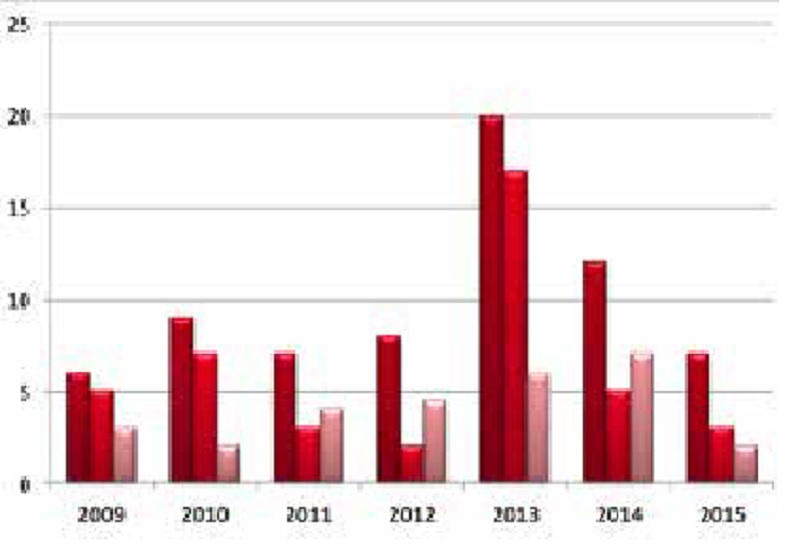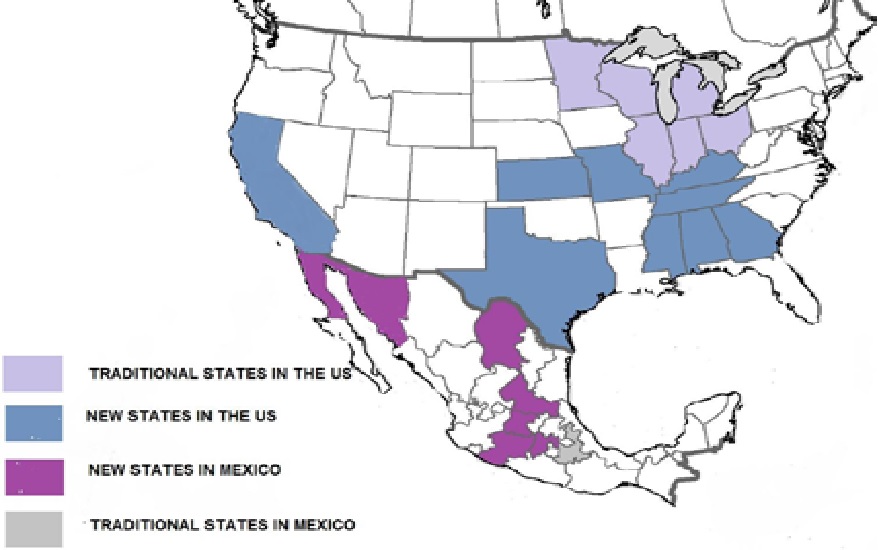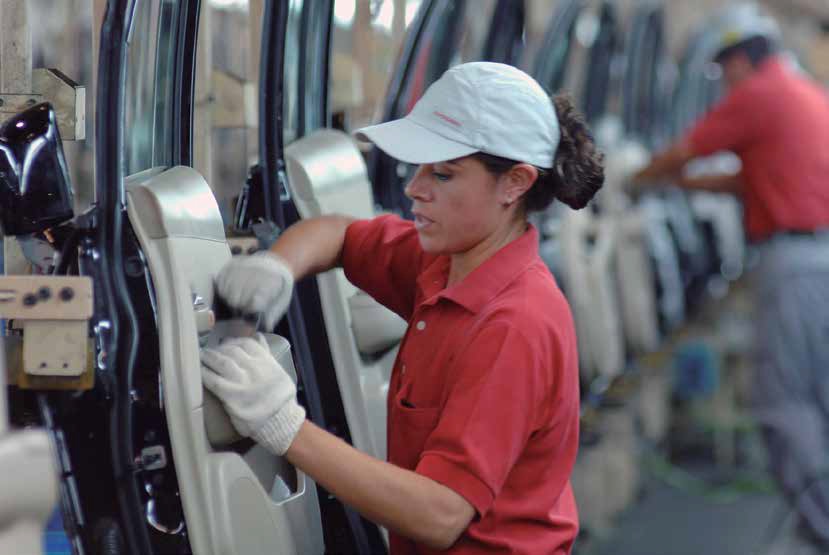“Nature required many millions of years in order to deposit gold,
silver, and oil in the subsoil of Mexico. The foreign imperialists wish to
plunder these riches in the shortest possible time, making use of cheap
labor power and the protection of their diplomacy and their fleet.”
The Mexican Oil Expropriations, Leon Trotsky, 1938
A new political and diplomatic crisis between the two countries is emerging: NAFTA, the vast imperialist enterprise, which has proven the lifeline and basis of stability for the Mexican regime and national bourgeoisie, is now being put into question by the Trump Administration.
Mexico’s situation today is more influenced by its relationship with the United States than ever. Even if Trump’s program is only partially implemented, it calls into question the model of integration with the United States, on which the fortress of the Mexican regime was built throughout the past decades, ensuring certain economic growth and garnering the support of broad social sectors, especially of the middle and upper classes, who have benefited from a consumerist boom. Since its implementation in 1994, NAFTA has transformed the Mexican economy into a manufacturing export-platform for US industry.
In the context of the global trend towards industrial outsourcing, Mexico is part of one of the most dynamic value chains in the world, making up the automotive components chain of NAFTA member-countries. The need to compete with other countries that receive massive flows of Foreign Direct Investment (FDI) led the Mexican regime to maintain the lowest wages among OECD member countries, causing some economists to label Mexico, “The China of the West.”
In addition to strengthening Mexican dependence on the United States economically, politically, and in security-related matters, the extreme imperialist penetration created a new Mexican working class.
An estimated 42 million workers are employed in the industrial, manufacturing, extraction and oil industry, maquila and service sectors. This army of men and women working in precarious conditions comparable to those of the 19th century constitutes a powerful social force that extends from the northern border to the middle of the country.
China of the West
The 2008 crisis shook Mexican industry, which is directly dependent on the US economy. However, contrary to most forecasts, after 2009 and in the context of the limited but undeniable improvement of the US economy, there was a significant recovery of the secondary sector (which includes manufacturing and industry) as part of an upward curve that started in 2003. Until the rise of Donald Trump, Mexico was going through an economic recovery that was in contrast with the downward trend of other Latin American economies, particularly the Southern Cone.
The most relevant sectors in this recovery were the automotive, electronics, and food and beverage sectors, in addition to cutting-edge sectors like aerospace. (See Graph 1).
GRAPH 1
Trends in Foreign Direct Investment (FDI) (2009-2015)

Data from de Mexican Department of Economy
Mexico’s maquiladora export industry, the country’s prevailing sector through 2003, has undergone significant changes. The geographic expansion of manufacturing industry over the past few years is especially noteworthy.
Until late 2008, when the global economic crisis broke out, there was patent inequality between the growthof the Mexican economy as a whole and that of the border states:
“While Mexico’s economy overall grew at an average rate of 2.9 percent in the 1993-2006 period, the region that includes all of the northern border states grew at a rate of 4.1 percent. The states of Baja California, Chihuahua and Nuevo León grew at a particularly rapid pace.”1
The relatively strong performance of industry in the border region is, in part, due to geographic proximity to the United States.
The entire border region became a pole of attraction for FDI, in particular from the United States, which increased 5.9 percent from 1994 to 2007.
Thus, states like Chihuahua, Baja California,Nuevo León and Sonora had much higher average growth rates throughout the period than the overall national rate.
The high growth rates were a result of the massive entry of investments oriented towards the maquiladora export industry.
“The state of Nuevo León, for its part, received investments both in the maquiladora industry and in the export manufacturing not included in the maquila system. In particular, FDI near the northern border were directed to labor intensive maquiladora plants, taking advantage of low wages and geographic proximity.”2
However, the industrial concentration has undergone a clear geographical expansion, propelled by two factors:
1) Imperialist capital’s aim to develop manufacturing for NAFTA’s markets.
2) The needs of local capital, advanced by the policies of the ruling party to counteract the Mexico’s dependence on oil exports.
Since 2007, the maquiladoras have become part of a specialized industry that has been referred to as a “third-generation maquiladora.”
Some authors and economists have noted this new form of maquiladora is based on the integration of the traditional maquila with “centers of research, design and development, i.e. based on highly qualified labor.
This is an emerging type of maquiladora with a higher level of technology and an apparent increase in decision-making autonomy. The work is characteristically highly qualified with a high level of responsibility.”3
These new production facilities are entirely dependent on FDI and are based on the import of US technology (and patents owned by US companies).
This, in the absence of statesanctioned labor protections, has given birth to a new workforce that is directly employed by multinationals and third parties providing outsourced services.
This trend increased after 2007 (partially interrupted only by the 2008-2009 crisis) because China began to experience a significant increase in wages and, as a consequence, an overall reduction in FDI levels.
In 2013, Mexico received 12.6 percent of the global FDI, which is the highest level recorded to date.
This is due not only to Mexico’s low wages, but also to the recovery of the US economy, which led to an overall recovery of countries within the NAFTA bloc–a comparative advantage Mexico has in relation to China.
Mexico is part of a global trend in which “from 1990 to 2010, the global work force (…) increased by 190 percent in ‘emerging’ countries compared
to 46 percent in advanced countries.”4
In addition to creating a global market, so-called productive globalization creates:
“a global working class, which essentially increases in emerging countries. Accompanied by a trend towards the wage labor of workers who did not previously work for a salary. The rate of salaried employment (the proportion of salaried workers in the workforce) has increased continuously, from 33 percent to 42 percent throughout the past 20 years.”5
There are millions of people who have become industrial wage workers as a result of migration from rural to urban centers, or to the growing integration of women in the labor market.
According to 2015 data from the National Institute of Statistics and Geography (INEGI), a total of almost seven million people work in the primary sector (agriculture and livestock). One and half million among them are day laborers.
About 12.5 million work in the secondary sector (industry, mining and energy) and a little over 31 million are employed in the tertiary sector (services).
The industrial, service, and agricultural proletariat combined constitute a force of almost 42 million people.
As mentioned earlier, the salaries of this new working class are far below the international average, even when compared to other semicolonial countries.
The Automobile Value Chain
The auto industry has surprised the world with its strong performance in the past few years, in particular as a result of the way in which the US economy was able to overcome–for the time being–the economic crisis that shook the global economy in 2008.
According to expert Alex Covarrubias Valdenebro:
“Apparently, the auto industry can keep growing at an even more unusual rate since we are witnessing a historical transition in which centers of industrial production and consumption are being relocated to emerging countries.”6
Valdenebro continues on to say that Mexico´s prominence in the automotive sector is fundamentally due to three relative advanteges in a comparison with other automotive giants as Brazil: The exceedingly low labor costs, México´s low tarriffs as a NAFTA member country and its increasingly qualified workforce.7
The automotive industry is undoubtedly the most dynamic sector in the Mexican economy.Mexico receives investments from all the Original Equipment Manufacturers (OEMS), which already provides over half a million of the best-paid jobs in manufacturing.
In addition, with the development of new assembly plants, the industry has fostered the creation of new “production chains” of “parts and components that are growing at an even more rapid pace than the assembly plants themselves.”8
According to a study by A.T. Kearney, Mexico “offers US corporations a way to reduce labor and production costs ‘right in their backyard.’”
According to PwC, there has been a production change in Mexico which went from being a country of “cheap labor-intensive manufacturing to a country of qualified and specialized assembly plants.”
The relocation of auto industries to the global South and peripheral countries is a response to what some are calling the ultimate crisis of the manufacturing sectors in core countries.According to Valdenebro:
“It is a historical event that we call late motorization and coincides with the energy, environmental, and industrial crisis that, in developed countries, is placing at the center of public life the demands for alternative systems of mobility as well as a transition towards knowledge-based economies.”
The positioning of Mexico as a US export platform also coincides with the loss of control over the global market by what was once known as the Big Three of Detroit, i.e. General Motors, Ford, and Chrysler.
The US giants, which were violently shaken by the 2008 crisis and only saved by the massive injection of capital by the US government, not only lost hegemony over global auto markets, but also over the domestic market.
According to several authors, the growth of the auto industry in Mexico involved manufacturing as well as marketing.
It is a value chain that is expanding to the periphery because of structural conditions, the massive investment of capital, increasing consumption of private cars, fixed capital development, and the availability of fossilfuel energy.
The auto industry has complex interconnections. On one hand, it is part of a network of auto parts and manufactured components.
On the other, it is integrated into distribution and sales networks, maintenance shops, and a subsector based on research and technological development. In the case of Mexico, it is an absolutely multinational industry.
By 2013, Mexico had produced almost three million cars. The auto industry generates an influx of foreign currency and makes up 23.5 percent of total exports and 31 percent of the total manufacturing sector.
In 2013, the sector’s exports brought $90 billion USD to the country and the auto industry’s share of the GDP was 3.8 percent, an increase of 27 percent from 2000.
The process of an increase in manufacturing exports counteracting the drop in oil exports is evident in the auto industry and operates on a general scale.
Although most product and process development activities have remained in imperialist countries, there are already seven OEMA engineering and design centers in Mexico.
Thanks to the aforementioned expansion, NAFTA’s auto parts production chain is one of the most extensive value chains in the world (See Map 1).
MAP 1
NAFTA Automotive Component Chain

Source: Valdenebro 2014
In addition, companies that exclusively produce auto parts extend throughout at least 21 Mexican states, including Aguascalientes, Baja California, Chihuahua, Jalisco, Nuevo León, Puebla, Querétaro and San Luis Potosí.
A total of 66,000 workers are employed in terminal plants and 700,000 workers are employed in the auto part industry.
Capital Without Borders
Eighty percent of manufacturing production in Mexico is exported to the United States.
The main companies operate under NAFTA; it follows, the situation of the vast number of workers employed by the auto plants appears uncertain after Trump’s victory.
But at the same time, in states like Michigan, Texas, North Dakota, Indiana, Vermont, Alabama and Ohio–just to name a few–, the economy depends in large part on international trade with Mexico to maintain their production.
Mexico is the US’s second largest trading partner: in 2016, the United States imported products from Mexico to the tune of $294 billion USD and US exports to Mexico were worth $231 billion dollars, according to the US Census Bureau.
In the United States, millions of Latino workers – mostly Mexican – are vital to agro-industry, construction, services, restaurants, and industrial production sectors. According to estimations, Latino workers contribute 32 percent of the GDP.
Despite Trump’s propaganda accusing Mexico of benefitting from NAFTA to the detriment of the US economy, US multinational corporations have, in fact, been the main beneficiaries of the agreement.
The Mexican bourgeoisie, which also received a significant share through the generalization of precarious work, has simply acted as a junior partner.
Capitalist development in the past quarter century has profoundly transformed the structure of the world economy.
The fact that different components of the same goods are produced in different parts of the world has created a new international division of labor.9
This new working class, which is limited in its movement by borders and migration restrictions, is heterogeneous and fragmentary due to wage differences.
On the other hand, capital has almost absolute mobility, which has led to competition among workers of different countries like never before in the history of capitalism.
As a result, “the wage gap between different countries has grown. In Mexico the average wage is 4 dollars a day (80 Mexican pesos), compared to 32 dollars
in the United States.”
The xenophobic and racist rhetoric against Mexican immigrants is aimed at reinforcing this competition among workers.
To counter this division, labor unions and workers in the US must fight against the exploitation of workers in Mexico and counter Trump’s chauvinistic discourse (ie., “Buy American”) campaign.
At the same time, workers in the US need to embrace the struggle for all rights for undocumented Latino workers. This has the potential to unite native and foreign-born workers in the US with the millions of workers in Mexico in a fight against the same bosses.
The only way in which the situation of millions of workers employed in NAFTA-member countries can possibly improve is through bringing about the end of the imperialist oppression of Mexico and Central America and capitalist exploitation on both sides of the border.
References
1 Mendoza, J.E., “El mercado laboral en la frontera norte de México: estructura y políticas de empleo,” in Estudios Fronterizos, vol. 11 no. 21 Mexicali Jan/Jun. 2010.
2 Mendoza, J.E., op. cit.
3 Idem.
4 Husson, M., “La formación de una clase obrera
mundial”, A través del espejo, Year 1,No. 1, 2015.
5 Ibid.
6 Valdenebro, A. C., “Explosión de la Industria Automotriz
en México: De sus encadenamientos actuales a su potencial
transformador”, in library.fes.de, March, 2014.
7 Ibid.
9 Ibid.











